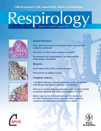Pleural space elastance and changes in oxygenation after therapeutic thoracentesis in ventilated patients with heart failure and transudative pleural effusions
Dr Chi-Li Chung and Dr Shi-Chuan Chang contributed equally to this work.
ABSTRACT
Background and objective: Therapeutic thoracentesis (TT) is required in patients with refractory pleural effusions and impaired oxygenation. In this study, the relationship between pleural space elastance (PE) and changes in oxygenation after TT was investigated in ventilated patients with heart failure and transudative pleural effusions.
Methods: Twenty-six mechanically ventilated patients with heart failure and significant transudative effusions, who were undergoing TT, were studied. The effusion was drained as completely as possible, with monitoring of pleural liquid pressure (Pliq) and chest symptoms. The volume of effusion removed, the changes in Pliq during TT, PE and arterial blood gases before and after TT were recorded.
Results: The mean volume of effusion removed was 1011.9 ± 58.2 mL. The mean Pliq decreased from 14.5 ± 1.0 to 0.1 ± 1.5 cm H2O after TT, and the mean PE was 15.3 ± 1.8 cm H2O/L. TT significantly increased the mean ratio of PaO2/fraction of inspired oxygen (FiO2) from 243.2 ± 19.9 to 336.0 ± 17.8 mm Hg (P < 0.0001). The changes in PaO2/FiO2 ratio after TT were inversely correlated with PE (r = −0.803, P < 0.0001). The 14 patients (54%) with normal PE (≤14.5 cm H2O/L) had significantly greater increases in PaO2/FiO2 ratio after TT than did the 12 patients with abnormal PE (>14.5 cm H2O/L).
Conclusions: Measurement of PE during TT may be valuable for predicting improvement in oxygenation in ventilated patients with heart failure and pleural effusions. Patients with lower PE showed greater improvement in oxygenation after TT.




